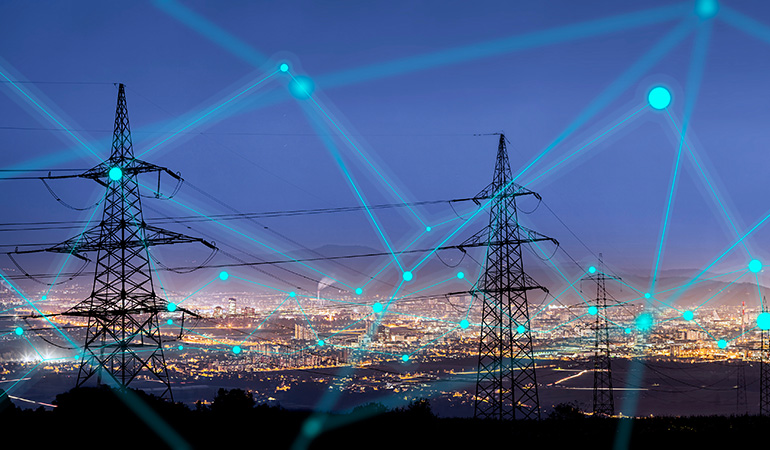One way in which the energy sector can catch up to today’s innovations is by using artificial intelligence (AI). What can artificial intelligence and machine learning development services give to the energy industry, and how can they make it safer and more efficient?
The possibilities of using artificial intelligence in energy and utilities in general are numerous and diverse. According to Research and Markets, the market for AI in the energy sector is growing at 24.6% annually as power generation companies continue to adopt AI-powered solutions to reshape and optimize their workflows.
Its capabilities for processing and analyzing data have found artificial intelligence multiple use cases in energy management and digital transformation of the entire energy sector.
In this post, you will learn about how AI is transforming the energy sector in terms of efficiency, optimization, sustainability, and operational safety. Let’s dive right in.

Source: ResearchGate
Key benefits of AI in the energy sector
The transformative power of artificial intelligence brings multiple benefits to the energy sector, reshaping the way energy is generated and delivered. With the right application of AI capabilities, energy companies can see significant operational improvements.
Higher efficiency
One of the main advantages of artificial intelligence is that it can take over multiple tasks that are usually performed by people. Moreover, it can perform them quicker, smarter, and more accurately.
The energy sector processes huge amounts of data, both real-time and historical. This is where AI can lend a virtual hand to analyze statistics on energy consumption, discern trends over time, process data received from hundreds of IoT devices, and streamline facility management with digital twin technology.
As a result, not only are business processes accelerated but the company gets unique insights based on accurate analysis of tons of data. Such insights might suggest more efficient patterns of energy distribution, raising the efficiency of power plants and grids.
Optimized generation
Providing detailed insights resulting from precise business analysis of long-term statistical data on energy generation, distribution, and consumption, AI applications can contribute to adjusting production to more closely meet demand.
Artificial intelligence takes into account demand peaks and dips based on historical data, environmental conditions, and power plant capacities to generate optimal production patterns. With this approach, power plants can streamline their production processes and minimize energy waste.
Cost reduction
Minimizing manual operations and optimizing energy production ultimately reduces overall energy costs. In the same vein, the use of AI in the energy sector can also be appreciated for its role in lowering equipment maintenance costs.
By monitoring various metrics of equipment used in energy production, AI applications can detect even minor deviations signaling potential failures. Such early detection allows energy companies using AI to take preventive measures and ensure that their equipment is in working condition. As a result, the company’s equipment maintenance costs are generally lower, which may be reflected in lower energy costs for customers.

Improved sustainability
Artificial intelligence and machine learning can help enterprises achieve greater sustainability and reduce their carbon footprint. By analyzing complex datasets including information about peak demand, weather conditions, and power plants involved in energy production, AI applications automatically monitor and control carbon monoxide emissions.
By decreasing production during periods of low demand or switching to solar panels in sunny weather, AI maximizes a plant’s efforts at reducing carbon emissions. AI tools can also reduce a company’s environmental impact through prioritizing renewable energy sources over fossil fuel-based generation while maintaining necessary production levels.
Work and operational safety
Preventive maintenance enabled by AI applications not only helps to reduce an energy company’s costs but also improves safety of a power plant, both for the general public and plant workers. By constantly monitoring data from multiple sensors, AI can detect failures early and help to prevent system overloads, excessive pressures and temperatures, power failures, and other factors that may jeopardize safety.
When used in hazardous working conditions, such as drilling rigs or high-voltage power plants, AI can provide accurate guidance and real-time alerts, reducing the risk of injury. At the same time, it can be used to track equipment statuses and issue early warnings of deviations from the norm.
Top AI use cases in energy sector
Whoever controls the strongest artificial intelligences controls the world
After all, AI is the technology of the century. It may seem that combining artificial intelligence with energy sector operations is too complex to be efficient. However, AI is steadily getting adopted by energy generation companies in multiple countries. Their strategies include modernizing the energy sector leveraging the capabilities of artificial intelligence, as it’s critical for every country’s economy.
Data digitization
As the world shifts in the direction of personalized digitalized services, the energy sector is trying to keep up with global trends. AI can help transform data collection, storage, and management, allowing the energy sector to catch up with the times.
Energy companies have a lot of data to manage. With the help of AI, they can store, process, and manage data more time- and cost-efficiently. Implementing innovative technology can help the energy industry become more competitive in an unstable economic environment and develop better operational methods than those currently available. Moreover, AI data management can reveal new insights that can completely change how the industry works.
AI forecasting
The world faces dramatic energy problems. Modern machines need more and more energy, and so does the global population. One of the major tasks of AI in the energy industry is predictive analytics.
Energy companies badly need to improve their predictive analysis methods to cut costs, save electricity, get ready for changing conditions, and provide better customer service. With the help of machine learning and deep learning, it’s possible to bring energy forecasting to the next level. Energy providers need to forecast changes in demand, system overloads, and possible failures as precisely as possible. The cost of error in the energy industry is high.
GE Power, which generates 30% of the world’s electricity, has incorporated artificial intelligence and machine learning to optimize generation and improve the company’s marketing strategy. With AI at the core, the forecasting platform provides clear visibility into market trends and provides actionable recommendations.

Resource management
Resource management is the next step for the energy sector after AI forecasting. With smart AI-powered predictive mechanisms, energy suppliers will be able to better dispatch their resources, prepare for demand in advance, predict problems, and save resources whenever possible. For end clients, saving power with AI will result in lower utility bills and higher flexibility, which are significant benefits of artificial intelligence in the energy market.
This is the approach that Schneider Electric took when searching for a solution for dynamic control over energy resources and building distributed power grids that enable efficient power generation and consumption.
Energy storage facilitation
Efficiently storing energy is tough. As the amount of power to be stored continues to grow, additional capacity and new energy management systems are needed. Artificial Intelligence can help industry actors to optimize their energy storage.
Storing renewable energy is problematic, as production of this energy is periodic and sometimes even chaotic. Uniting renewable energy with AI-powered storage can greatly facilitate energy storage management, increasing business value and minimizing power losses.
Envision Energy, a global renewable and green technology leader based in Denmark, leverages the outstanding capabilities of AI and IoT to drive its Envision Energy Storage Systems. The solution provides a flexible and customizable method of storing energy obtained from renewable sources, such as wind turbines.
Failure prediction and prevention
In the energy sector, failures can lead to truly massive disasters, from nationwide downtimes resulting from generation equipment breakdowns to fires, oil spills, or gas explosions. Energy companies invest millions in preventive monitoring to maintain equipment in a safe condition and ensure continuous accident-free operation.
Artificial intelligence can significantly improve energy equipment reliability. AI-powered monitoring can become the force enabling energy companies to transition from reactive to predictive maintenance. Intelligent tools monitoring equipment in real time can alert operators about any deviations from the norm early enough for them to take necessary steps and prevent a failure or accident.
Global leaders such as Siemens recognize the value of technology in predictive equipment maintenance and implement AI energy solutions to increase the availability and sustainability of energy-generating equipment.
Increased sustainability
In the context of sustainable development and climate change prevention, the energy sector is under especially close scrutiny. This industry is one of the main producers of greenhouse gas emissions and other pollutants. As a result, energy companies are searching for ways to reduce their carbon footprint by implementing technology-loaded solutions.
With its outstanding capabilities for monitoring and analyzing massive data volumes, AI can be of tremendous help in minimizing gas emissions. Power plants using AI to track emissions can optimize their performance and lower their environmental impact. This is among the digital transformation initiatives implemented by ExxonMobil. The global energy corporation uses AI to optimize its refinery operations and reduce atmospheric pollution.
Energy trading
Today’s energy market is complex and diverse, making trading a challenge. Decision-making requires real-time analysis of tons of data on pricing, supply, demand, and other conditions influencing energy prices. As the volume of information grows, manual trading becomes next to impossible.
AI, on the other hand, has no issues with processing large amounts of data from diverse sources and generating accurate insights. It can evaluate potential risks, assess market volatility, compare different scenarios, and suggest decisions maximally adapted to the current market situation.
An increasing number of energy companies are recognizing the advantages of AI-driven algorithmic trading. For example, Statkraft, a Norwegian renewable energy producer, is experimenting with algorithmic trading based on artificial intelligence and machine learning to accelerate trading and increase value for customers.
Smart grids
With sustainability in mind, energy companies are implementing smart grids where power generation and distribution respond dynamically to changes in demand and consumption. With this approach, energy companies can be better prepared for sudden peaks in demand and redistribute resources in the event of equipment failure.
With artificial intelligence, managing smart grids becomes even more streamlined. AI algorithms can not only analyze current and historical trends but can also make validated forecasts, enabling companies to allocate resources more efficiently. Enel, an Italian green energy company focused on environmental protection and sustainability, implements AI in designing its green grids to increase the efficiency of resource use in power generation and reduce carbon emissions.
Energy production applications with the greatest demand for AI

Integration of AI in the energy sector is becoming increasingly relevant for automation, reducing CO2 emissions, enabling preventive maintenance, and ensuring transparent and secure operations, offering opportunities for source transitions, business transformations, and forward-looking digital strategies.
Renewable energy, which is steadily gaining momentum, stands out as a leader in integrating AI technologies, using AI to optimize cross-functional operations by analyzing extensive data on weather patterns and energy consumption. This enhances efficiency, improves forecasting accuracy, and streamlines maintenance.
Furthermore, AI is driving significant progress in thermal energy production, benefiting technologies like geothermal and concentrated solar power. By optimizing resource allocation and predicting energy demand fluctuations, precise machine-enabled control over thermal energy production improves reliability and cost-effectiveness.
In nuclear energy, AI algorithms enhance safety measures, refine reactor performance, and manage radioactive waste procedures, ensuring uninterrupted operations while minimizing environmental impact.
Beyond these applications, AI is catalyzing positive changes across once-traditional fuel extraction, grid management, and energy storage practices. AI enhances exploration processes in fossil fuel extraction while minimizing environmental impact. Grid management systems powered by AI optimize energy distribution networks, adapting to fluctuating demand and integrating diverse energy sources without extra effort. Additionally, AI-driven energy storage solutions hold promise in mitigating the intermittency challenges linked to renewable energy sources, thereby expediting the shift towards a sustainable energy future.
Regulation of AI for the energy industry
Currently, the majority of governments globally are still considering implementing regulations on the use of artificial intelligence in various areas, including the energy sector. Dependence on electricity is so great in every aspect of our lives that both accidental and intentional disruptions to its supply can have devastating consequences. Thus, it is critical that the use of AI in managing energy production and distribution is regulated and closely monitored.
Several governments are considering implementing regulations restricting the use of AI. One of them is the European Union Artificial Intelligence (AI) Act, which, at the time of this publication, is still at the proposal stage. When it comes into force, it will restrict AI applications that are regarded as posing an unacceptable or high risk to society and will evaluate others that are considered of limited risk.
According to the classification laid down in the Act, energy systems are “high risk,” as they belong to the area of “management and operation of critical infrastructure.” Therefore, we may expect laws and regulations in EU Member States to clamp down on the use of AI in the energy sector after the Act is passed to prevent AI-induced grid or production failures and supply disruptions.
Key challenges of AI in the energy sector
Alongside all the benefits of AI in the energy sector, companies adopting this pioneering technology must take into account all its caveats, too. Nothing is perfect, but good planning and expert guidance can help businesses overcome eventual challenges and leverage the unique opportunities AI brings to their workflows.

High energy consumption
While contributing to smarter energy generation and distribution in an effort to lower carbon emissions, AI applications themselves consume energy in amounts that are starting to look alarming.
Large language models used in AI tools require powerful data centers to train and maintain them, consuming an increasingly high amount of energy. The power consumption for the entire AI industry might become equal to that of a country the size of the Netherlands by 2027. In addition, data centers running AI applications need lots of water for cooling, which also leaves its environmental footprint.
Such concerns need to be taken seriously. Businesses should take a comprehensive approach to evaluating the pros and cons of AI for meeting their goals and adopt the most efficient methods for its use. In the long-term perspective, regulations limiting the use of AI may even be required to control power consumption.
Lack of theoretical background
One reason for the slow adoption of AI in the energy industry is a lack of necessary knowledge about AI technology among decision-makers. Many companies simply don’t have a sufficient technical background to understand how their business can benefit from AI adoption. Conservative stakeholders prefer to stick with time-proven methods and tools rather than risk trying something new.
As more industries like education, finance, healthcare, and transportation embrace the potential of AI, decision-makers in the energy world are turning their attention to this technology as well.
Lack of practical expertise
AI is still a new technology, and professionals who have mastered it are few. There are a lot of experts with in-depth theoretical knowledge of the subject. Yet, it’s immensely hard to find professionals able to build robust AI-powered software that has real practical value. What’s more, the energy sector is highly conservative.
Even though energy companies collect and manage data, digitizing it with innovative transformation solutions is problematic. There are associated risks of data loss, poor customization, system failure, and unauthorized access. Since the cost of error is high in the energy industry, many companies are reluctant to risk trying new approaches they have no experience with.
Outdated infrastructure
Outdated infrastructure is the largest stumbling block to modernization of the energy sector. Currently, utility companies find themselves buried in piles of data, having no idea how to cope with it. While the energy industry has more data than most, that data is often distributed, disorganized, scattered across different formats, and stored only locally. And while having huge profits, energy companies also suffer great losses due to the vulnerabilities of outdated systems.
Financial pressure
Implementing innovative smart technology in the energy sector could be the best option, but it’s certainly not the cheapest. Searching for an experienced software services provider, developing and customizing software, and adjusting, managing, and monitoring it takes a lot of time and resources.
Before businesses can fully enjoy the benefits of AI in the energy sector and start implementing artificial intelligence, machine learning, and deep learning into their strategies, they must be willing to allocate an impressive budget and accept the risks of changing their outdated systems.

Will AI affect energy workers?
One of the main concerns that AI raises in society is eventual displacement of workers. True, due to its superb ability to perform routine and repetitive tasks, AI can take over some low-skill jobs.
At the same time, the use of AI opens multiple job opportunities for engineers, developers, and project managers involved in the creation, training, and maintenance of artificial intelligence models. These trends are also observed in the energy sector.
Moreover, as AI contributes significantly to the transition to green energy and sustainability-centered energy generation, it creates demand for related professionals. Infrastructure engineers, sustainability experts, and renewable energy technicians will be hunted by many companies choosing the clean energy path.
Globally, the green transition could create 30 million jobs in clean energy, efficiency and low-emissions technologies by 2030.
Last but not least, in the energy sector, as everywhere else, artificial intelligence creates a safer working environment. AI-powered early failure detection, metrics monitoring, and predictive maintenance ensure safe and consistent equipment operation, reducing the probability of work-related hazards for personnel.
Final thoughts
Today’s economy is saturated with modern technology, tools, and machine-powered applications, from interconnected digital platforms to robots and algorithms. The energy sector, being fundamental for humanity, is actively searching for practical applications of innovative technologies and continually exploring and evaluating emerging advancements. Artificial intelligence has the potential to revolutionize this sector globally. Soon enough, AI is expected to transition from a handy technology to the most efficient decision-maker the energy industry has ever seen. Though not without critical challenges, it is predicted to reduce manual work, minimize risks, and enhance data and asset management. In short, the promise of AI for the energy sector goes beyond digital transformation, offering a path toward a better future for humanity when complemented by human intelligence.
Contact us to be at the forefront of innovations disrupting the energy sector.


